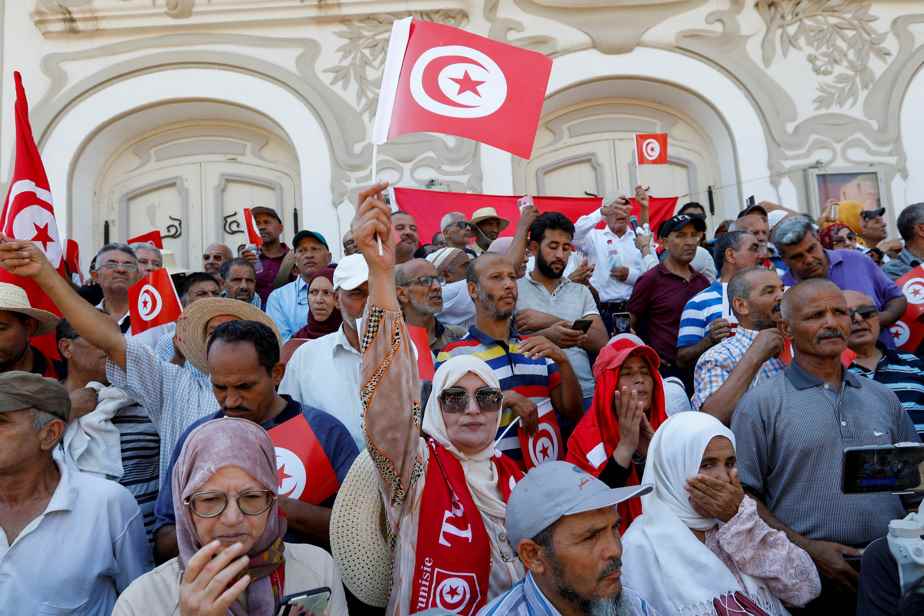(Tunis) Tunisians are called on Monday to vote in a referendum imposed by the head of state, Kais Saied, on a controversial new constitution which strengthens the powers of the president and could lead the country back to a similar dictatorial regime before 2011.
Posted at 10:14 p.m.
From 5 a.m. to 9 p.m. GMT, more than 11,000 polling stations are ready to welcome voters, according to Isie, the electoral authority, organizer of a poll supposed, according to Mr. Saied, to end the political crisis caused by his coup of exactly one year ago.
According to Isie, 9,296,064 Tunisians were registered voluntarily or automatically to participate in this referendum, which was rejected by the majority of political parties and criticized by rights defenders. The 356,291 Tunisians abroad began voting on Saturday and have until Monday to vote.
Participation is the main issue of the referendum for which no quorum is required and where the yes is given preference, the opposition to Mr. Saied having essentially called not to go to the polls.
The draft Constitution establishes an ultra-presidential regime granting vast powers to the Head of State, breaking with the rather parliamentary system in place since 2014, to which Mr. Saied blames the recurring conflicts between Parliament and the government of the past 10 years.
In the new text, the president, supreme commander of the armed forces, exercises executive power with the help of a head of government that he appoints and can dismiss him at his pleasure, without having to obtain the confidence of Parliament. It ratifies the laws and can also submit to Parliament legislative texts which have “priority”.
A second chamber to represent the regions will be established to counterbalance the current Assembly of Representatives (deputies).
The opposition and NGOs have denounced a text “tailor-made” for Mr. Saïed, and an excessive concentration of powers in the hands of a president who is not accountable to anyone.
Sadok Belaïd, the lawyer commissioned by Mr. Saied to draw up the new Constitution, disavowed the final text, believing that it could “open the way to a dictatorial regime”.
“Heading correction”
The largest opposition parties, including the Islamist-inspired movement Ennahdha, Mr. Saied’s pet peeve, have called for a boycott of the ballot, citing an “illegal process” and without consultation.
The powerful UGTT trade union center, which keeps a distance from political life on which it had a strong influence since the 2011 Revolution, did not give voting instructions.
An inscrutable and complex character, President Saied has exercised power in an increasingly solitary way for the past year.
Aged 64, Mr. Saied considers his overhaul of the Constitution as an extension of the “correction of course” initiated on July 25, 2021 when, citing political and economic blockages, he dismissed his Prime Minister and froze Parliament before dissolve it in March, jeopardizing the only democracy that emerged from the Arab Spring.
For researcher Youssef Cherif, “the fact that people can still express themselves freely, that they can vote no (in the referendum) without going to prison shows that we are not in the traditional pattern of dictatorship”.
But the question could arise, according to him, in the post-Saied period, with a Constitution which “could build an authoritarian regime resembling the regimes that Tunisia knew before 2011”, the dictatorship of Zine el Abidine Ben Ali and the autocratic independence hero Habib Bourguiba.
In the aftermath of the vote, the President’s main challenge will remain the serious economic situation with sluggish growth (around 3%), high unemployment (40% among young people), galloping inflation, accentuated by the war in Ukraine and the increase in the number of poor to 4 million people.
Tunisia, in deep financial crisis with a debt exceeding 100% of GDP, has been negotiating for months a new loan with the IMF which, before the referendum, reported “satisfactory progress” towards an agreement, but will require in return for sacrifices, likely to provoke reactions in the street.
